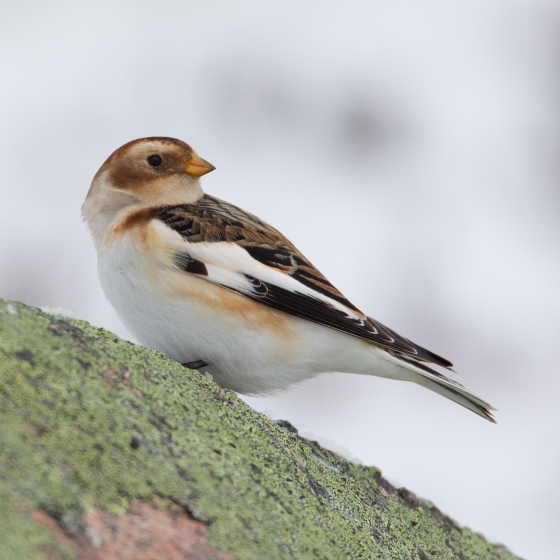Snow Bunting
Plectrophenax nivalis (Linnaeus, 1758)
SB
 SNOBU
SNOBU  18500
18500

Family: Passeriformes > Calcariidae

Snow Buntings are predominantly a winter visitor to Britain & Ireland although a tiny breeding population remains amongst snow fields on the highest Scottish mountains.
Winter visitors from northern breeding grounds in Iceland and Fennoscandia are widely distributed across the uplands of Scotland and England, and to a lesser extent Wales and the island of Ireland. However, most birdwatchers will encounter flocks of this confiding little bird on North Sea coasts from the Tees to Norfolk. The population in winter has increased by a third in 40 years.
In the breeding season, Snow Buntings adopt a very smart white summer dress, with black wings and tail making a superb contrast as they flutter across high mountain snowfields with their sweet bubbling call. You have to be lucky or determined to see them though, as the most recent survey identified only around 80 breeding territories in this harsh landscape.
Identification
Snow Bunting identification is often straightforward. The following article may help when identifying Snow Bunting.
Identifying winter buntings

If you find brown, streaky buntings hard to identify, this workshop is for you. Using video footage, still photographs and sound recordings we highlight the differences between four species of bunting that can be found in coastal areas in winter: Reed, Little, Snow and Lapland Buntings.
SONGS AND CALLS
Listen to example recordings of the main vocalisations of Snow Bunting, provided by xeno-canto contributors.
Call
Song
Develop your bird ID skills with our training courses
Our interactive online courses are a great way to develop your bird identification skills, whether you're new to the hobby or a competent birder looking to hone your abilities.
Browse training coursesStatus and Trends
Population size and trends and patterns of distribution based on BTO surveys and atlases with data collected by BTO volunteers.
CONSERVATION STATUS
This species can be found on the following statutory and conservation listings and schedules.
POPULATION CHANGE
The Snow Bunting is restricted as a UK breeding species to mountainous areas of Scotland where it breeds in small numbers. It is an Rare Breeding Birds Panel species but is under-reported due to the difficulties in finding and monitoring birds in such challenging habitat (Eaton et al. 2021). It is believed that the population may have increased during the 1970s and 1980s although the possibility that the recorded increases may have resulted from higher levels of observer coverage cannot be ruled out (Watson & Smith 1991).The population appears to have subsequently remained relatively stable and the population estimate from the last full survey in 2011 was 60 territories (Hayhow et al. 2018). The breeding range in 2008–11 was substantially larger than it was in 1968–72 but smaller than in 1988–91 (Balmer et al. 2013).
DISTRIBUTION
A small relict population of Snow Buntings breeds on the high tops of mountains in the Cairngorms and northwest Highlands. During 2008–11
Occupied 10-km squares in UK
| No. occupied in breeding season | 32 |
| % occupied in breeding season | 1.1 |
| No. occupied in winter | 989 |
| % occupied in winter | 33 |
European Distribution Map
DISTRIBUTION CHANGE
The Snow Bunting range extent detected in 2008–11 was substantially larger than in the 1968–72 Breeding Atlas but smaller than in the 1988–91 Breeding Atlas. Occupancy figures are likely to be heavily influenced by the intensity of coverage on the high tops inhabited by this species. Nevertheless, other data confirm this trend. In winter there has been a 34% range expansion since the 1980s, with gains in the uplands and on the margins of the coastal range, in south and southwest England, Wales and Ireland.
Change in occupied 10-km squares in the UK
| % change in range in breeding season (1968–72 to 2008–11) | +128.6% |
| % change in range in winter (1981–84 to 2007–11) | +33.3% |
SEASONALITY
Snow Bunting is a localised breeder, autumn passage migrant and localised winter visitor.

Movement
Information about movement and migration based on online bird portals (e.g. BirdTrack), Ringing schemes and tracking studies.
RINGING RECOVERIES
View a summary of recoveries in the Online Ringing Report.
Foreign locations of birds ringed or recovered in Britain & Ireland

Biology
Lifecycle and body size information about Snow Bunting, including statistics on nesting, eggs and lifespan based on BTO ringing and nest recording data.
SURVIVAL & LONGEVITY
View number ringed each year in the Online Ringing Report
Maximum Age from Ringing 
|
8 years 11 months 2 days (set in 2005) 
|
Typical Lifespan 
|
3 years with breeding typically at 1 year |
Adult Survival 
|
0.63  
|
BIOMETRICS
Wing Length 
|
Adults | 106.5±4 | Range 102–113mm, N=1535 |
| Juveniles | 106.4±3.1 | Range 102-113mm, N=1231 | |
| Males | 110.2±3.3 | Range 104–115mm, N=348 | |
| Females | 105.4±3.5 | Range 102–109mm, N=1184 |
Body Weight 
|
Adults | 33.0±3.3 | Range 28.5–39.0g, N=1386 |
| Juveniles | 31.4±2.4 | Range 27.8–35.8g, N=1047 | |
| Males | 35.1±3.4 | Range 30.5–40.9g, N=309 | |
| Females | 32.5±3 | Range 28.4–37.7g, N=1074 |
Feather measurements and photos on featherbase 
CODES & CLASSIFICATION
Ring size 
|
B |
Field Codes 
|
2-letter: SB | 5-letter code: SNOBU | Euring: 18500 |
For information in another language (where available) click on a linked name
Research
Interpretation and scientific publications about Snow Bunting from BTO scientists.
CAUSES AND SOLUTIONS
Causes of change
The small UK Snow Bunting population is believed to have remained relatively stable since at least the 1990s following previous increases (Hayhow et al. 2018) suggesting conditions have remained relatively favourable for this species. However, there are concerns that the species is likely to be vulnerable to climate change as Scotland lines at the far south of its breeding range (Chamberlain & Pearce-Higgins 2013) and declines and range losses have been reported elsewhere in Europe (Eaton et al. 2021).
Would you like to search for another species?












Share this page